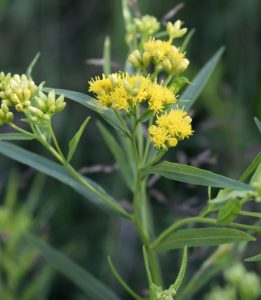Grass-leaved Goldenrod
 Euthamia graminifolia, aka flat-top goldenrod, is nice to have around as a sparkling reminder that every genus has its unique surprises to keep us on our toes and look closely. Relatively recently, grass-leaved goldenrod was reclassified from its former placement in the Solidago genus (the genus that includes most goldenrods) into the genus, Euthamia, due to a few important differences due to flowerhead arrangement and leaf anatomy. Like the Solidagos, Euthamias still remain in the Aster family with their tiny, barely spreading ray petals. Their bloom time is similar as well, July into September. Indeed, on first glance, the grass-leaved goldenrods I discovered growing in the sandy soil beneath the beach area’s jack pines certainly bore a strong resemblance to goldenrods, and yet — with a difference that tickled my curiosity, so different are their diminutive flower clusters and very narrow, short leaves from true goldenrods. Leaves are only 1/8″ to 1/2″ wide, and the flower clusters are bushy and rather flat-topped.
Euthamia graminifolia, aka flat-top goldenrod, is nice to have around as a sparkling reminder that every genus has its unique surprises to keep us on our toes and look closely. Relatively recently, grass-leaved goldenrod was reclassified from its former placement in the Solidago genus (the genus that includes most goldenrods) into the genus, Euthamia, due to a few important differences due to flowerhead arrangement and leaf anatomy. Like the Solidagos, Euthamias still remain in the Aster family with their tiny, barely spreading ray petals. Their bloom time is similar as well, July into September. Indeed, on first glance, the grass-leaved goldenrods I discovered growing in the sandy soil beneath the beach area’s jack pines certainly bore a strong resemblance to goldenrods, and yet — with a difference that tickled my curiosity, so different are their diminutive flower clusters and very narrow, short leaves from true goldenrods. Leaves are only 1/8″ to 1/2″ wide, and the flower clusters are bushy and rather flat-topped.
In the end, DNA analysis gave botanists the impetus they needed to reclassify these former ‘goldenrods’ into their correct genus. The retention of the common name certainly gives a sense of the history here. It can take a real adjustment to get used to a new name, sort of like when a street name occasionally gets changed, while everyone still refers to it by its former. Keeping track of the correct genus, however, is important for scientific studies in adding to the database and for the correct interpretation of gathered results.
